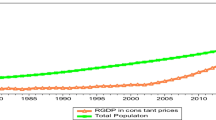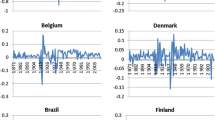Abstract
This study examined the relationship between population growth and economic growth in China. It employed innovative econometric methods including the breakpoint unit root test, the autoregressive distributed lag method, the bounds test for cointegration and the Toda–Yamamoto causality test. The empirical analysis detected a negative long-run relationship and bidirectional causality between population and economic growth. This means that the findings suggested that population growth was a cause and an effect of economic growth. The study concluded that population expansion could be detrimental to economic growth in China. At the same time, economic growth could stem population expansion.
Similar content being viewed by others
References
Akaike, H.: A new look at the statistical model identification. IEEE Trans. Autom. Control 19, 16–723 (1974)
Breitung, J.: Rank tests for nonlinear cointegration. J. Bus. Econ. Stat. 19, 331–340 (2001)
Darrat, A.F., Al-Yousif, Y.K.: On the long-run relationship between population and economic growth: some time-series evidence from developing countries. East Econ. J. 25, 301–313 (1999)
Dawson, P.J., Tiffin, R.: Is there a long-run relationship between population growth and living standards? The case of India. J. Dev. Stud. 34, 149–156 (1998)
Dickey, D.A., Fuller, W.A.: Distribution of the estimators for autoregressive time series with a unit root. J. Am. Stat. Assoc. 74, 427–431 (1979)
Easterlin, R.A.: Effects of population growth on the economic development of developing countries. Ann. Am. Acad. Polit. Soc. Sci. 369, 98–108 (1967)
Engle, R.F., Granger, C.W.J.: Cointegration and error correction: representation, estimation and testing. Econometrica 55, 251–276 (1987)
Furuoka, F.: Population and economic development in Indonesia: a revisit with new data and method. Acta. Oecon. 63, 451–467 (2013)
Garza-Rodriguez, J., Andrade-Velasco, C.I., Martinez-Silva, K.D., Renteria-Rodriguez, F.D., Vallejo-Castillo, P.A.: The relationship between population growth and economic growth in Mexico. Econ. Bull. 36, 97–107 (2016)
Granger, C.W.J.: Investigating causal relations by econometric models and cross-spectral methods. Econometrica 37, 424–438 (1969)
Gregory, A.W., Hansen, B.E.: Residual-based tests for cointegration in models with regime shifts. J. Econom. 70, 99–126 (1996)
Hasan, M.S.: The long-run relationship between population and per capita income growth in China. J. Policy Model. 32, 355–372 (2010)
Johansen, S.: Estimation and hypothesis testing of cointegration vectors in Gaussian vector autoregressive models. Econometrica 59, 1551–1580 (1991)
Kuznets, S.: Population and economic growth. Proc. Am. Philos. Soc. 111, 170–193 (1967)
Kwiatkowski, D., Phillips, P.C.B., Schmidt, P., Shin, Y.: Testing the null hypothesis of stationary against the alternative of a unit root. J. Econom. 54, 159–178 (1992)
Perron, P., Vogelsang, T.J.: Non-stationarity and level shifts with an application to purchasing power parity. J. Bus. Econ. Stat. 10, 301–320 (1992)
Pesaran, M.H., Shin, Y.: An autoregressive distribution-lag modelling approach to cointegration analysis. In: Strøm, S. (ed.) Econometrics and economic theory in the 20th century: the Ragnar Frisch centennial symposium, pp. 371–413. Cambridge University Press, New York (1999)
Pesaran, M.H., Shin, Y., Smith, R.: Bounds testing approaches to the analysis of level relationships. J. Appl. Econom. 16, 289–326 (2001)
Phillips, P.C.B., Perron, P.: Testing for a unit root in time series regression. Biometrika 75, 335–346 (1988)
Rambaldi, A., Doran, H.: Testing for Granger non-causality in cointegrated systems made easy. Working Papers in Econometrics and Applied Statistics, No. 88, Department of Econometrics, University of New England (1996)
Savas, B.: The relationship between population and economic development: empirical evidence from the Central Asian economies. J. Cent. Asia Cauc. Stud. 6, 135–153 (2008)
Singha, K., Jaman, M.S.: Nexus between population and economic growth in India: a co-integration analysis. Sci. J. Pure Appl. Sci. 1, 90–96 (2012)
Stockwell, E.G.: The relationship between population growth and economic development. Am. Sociol. Rev. 27, 250–252 (1962)
Thirlwall, A.P.: A cross section study of population growth and the growth of output and per capita income in a production function framework. Manch. Sch. 40, 339–356 (1972)
Thornton, J.: Population growth and economic growth: long-run evidence from Latin America. South. Econ. J. 68, 464–468 (2001)
Toda, H.Y., Yamamoto, T.: Statistical inference in vector autoregressions with possibly integrated process. J. Econom. 66, 225–250 (1995)
Vogelsang, T.J., Perron, P.: Additional test for unit root allowing for a break in the trend function at an unknown time. Int. Econ. Rev. 39, 1073–1100 (1998)
Wong, H.T., Furuoka, F.: The relationship between population and economic growth in Asian economies. ASEAN Econ. Bull. 22, 314–330 (2005)
World Bank: World Development Indicators. http://data.worldbank.org/data-catalog/world-development-indicators (2016). Accessed 16 February 2016
Yao, W., Kinugasa, T., Hamori, S.: An empirical analysis of the relationship between economic development and population growth in China. Appl. Econ. 45, 4651–4661 (2013)
Zhang, S.: Analysis of the correlation between population growth and economic development in Asian countries. Cross Cult. Commun. 11, 1–6 (2015)
Acknowledgements
The analysis was conducted using the Ox program. The author is grateful to Professor Jurgen A. Doornik of Oxford University for providing OxEdit free of charge for academic purposes. The data and OxGauss codes for this study are available at: https://sites.google.com/site/fumitakafuruokaswebpage/data-and-oxgauss-codes-ii/paper-21.
Author information
Authors and Affiliations
Corresponding author
Rights and permissions
About this article
Cite this article
Furuoka, F. Is population beneficial to economic growth? An empirical study of China. Qual Quant 52, 209–225 (2018). https://doi.org/10.1007/s11135-016-0463-6
Published:
Issue Date:
DOI: https://doi.org/10.1007/s11135-016-0463-6






